A money tree is a popular houseplant that is known for its unique coin-shaped leaves. The money tree is native to Central and South America and is a member of the linden family. The money tree is a symbol of good luck and is often given as a gift. The money tree is easy to care for and can thrive in a variety of conditions. However, yellow spots on the leaves of a money tree can be a sign of a problem. There are a number of potential causes of yellow spots on a money tree, including sun damage, nutrient deficiencies, pests, and diseases. Luckily, there are a number of ways to treat yellow spots on a money tree. With a little care and attention, your money tree can be healthy and happy.
What Causes Yellow Spots on Money Trees?
One of the most common problems with money trees is yellowing leaves. There are a number of possible causes for this, including:
– too much sun
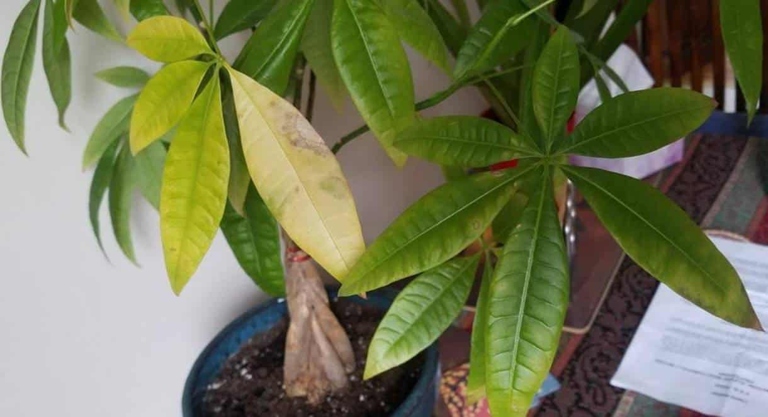
– too much water
– not enough nutrients
– pests or diseases
For example, if the tree is getting too much sun, move it to a shadier spot. And if it’s lacking nutrients, fertilize it with a balanced fertilizer. If you notice yellow spots on your money tree, try to determine the cause and take corrective action. If it’s getting too much water, let the soil dry out more between watering.
If you can’t figure out the cause of the yellowing, or if the tree doesn’t respond to your corrective measures, it’s best to consult with a professional. A certified arborist or tree doctor can diagnose the problem and recommend the best course of action.
Scorch Cause Damages to Green Chlorophyll
Scorch is a type of damage that can occur to green chlorophyll. The leaves of a money tree are especially susceptible to this type of damage. Scorch can be caused by a number of things, including too much sun, too much heat, or too little water.
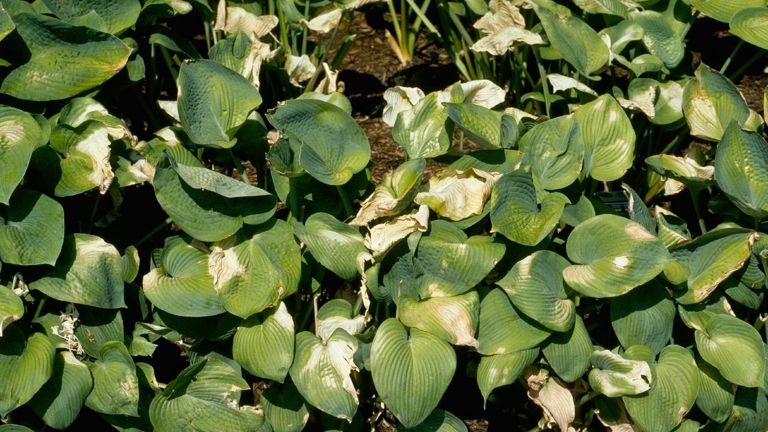
If the damage is severe enough, the leaves may fall off the tree. The leaves may also become dry and brittle. Scorch damage is characterized by yellow or brown spots on the leaves of a money tree.
The best way to prevent scorch damage is to provide the tree with adequate water and shelter from the sun. Scorch damage is not permanent, but it can take a long time for the money tree to recover.
Solution
There are a number of possible causes, and most of them are easily treatable. If you notice yellow spots on your money tree, don’t panic.
Money trees prefer bright, indirect light, so if yours is getting too much direct sun, the leaves will start to turn yellow. One common cause of yellowing leaves is simply too much sun. Move your tree to a spot with less sun exposure and the yellowing should stop.
Yellowing can also be caused by over- or under-watering. If the soil is too dry, the leaves will start to turn yellow. Water your tree when the top inch or so of soil is dry. If the soil is too wet, the leaves will turn yellow and then brown and drop off. Money trees like to have moist soil, but they don’t like to be sitting in water.
Try running a humidifier near your tree or placing it on a pebble tray. If you suspect your tree is getting too much or too little water, you can also try to adjust the humidity around it. Money trees like humid conditions, so if the air in your home is too dry, the leaves may start to turn yellow.
Money trees need to be fertilized every few months to make sure they’re getting all the nutrients they need. If you’ve ruled out too much sun, too much or too little water, and low humidity, another possible cause of yellowing leaves is a nutrient deficiency. If you think your tree might be lacking in nutrients, give it a dose of liquid fertilizer and see if that helps.
Finally, if you’ve tried all of the above and the yellowing leaves persist, it’s possible that your money tree is suffering from a pest infestation. Check the leaves for signs of insects or fungus and treat accordingly.
There are a number of possible causes, and most of them are easily treatable. If you notice yellow spots on your money tree, don’t panic.
Money trees prefer bright, indirect light, so if yours is getting too much direct sun, the leaves will start to turn yellow. One common cause of yellowing leaves is simply too much sun. Move your tree to a spot with less sun exposure and the yellowing should stop.
Yellowing can also be caused by over- or under-watering. If the soil is too dry, the leaves will start to turn yellow. Water your tree when the top inch or so of soil is dry. If the soil is too wet, the leaves will turn yellow and then brown and drop off. Money trees like to have moist soil, but they don’t like to be sitting in water.
Try running a humidifier near your tree or placing it on a pebble tray. If you suspect your tree is getting too much or too little water, you can also try to adjust the humidity around it. Money trees like humid conditions, so if the air in your home is too dry, the leaves may start to turn yellow.
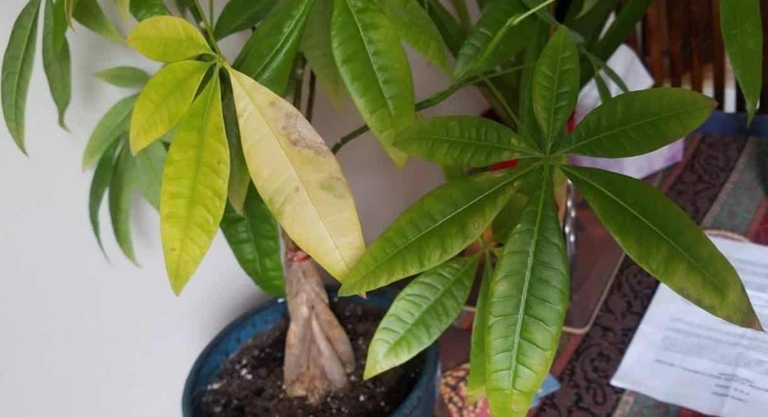
Money trees need to be fertilized every few months to make sure they’re getting all the nutrients they need. If you’ve ruled out too much sun, too much or too little water, and low humidity, another possible cause of yellowing leaves is a nutrient deficiency. If you think your tree might be lacking in nutrients, give it a dose of liquid fertilizer and see if that helps.
Finally, if you’ve tried all of the above and the yellowing leaves persist, it’s possible that your money tree is suffering from a pest infestation. Check the leaves for signs of insects or fungus and treat accordingly.
Downy Mildew Cause Mottling on leaves
Downy mildew can be treated with a fungicide, but it is important to catch it early. Mottling on leaves is often caused by downy mildew. This fungal disease thrives in humid conditions and can cause yellow spots on money tree leaves. Mottling can also be caused by other diseases, such as powdery mildew or leaf spot.
Solution
There are a few possible causes, and most of them are easily remedied. If you notice yellow spots on your money tree, don’t panic.
Money trees prefer bright, indirect light, so if yours is getting too much direct sun, the leaves will start to turn yellow. One common cause of yellowing leaves is simply too much sun. Move your tree to a spot with less sun exposure and the yellowing should stop.
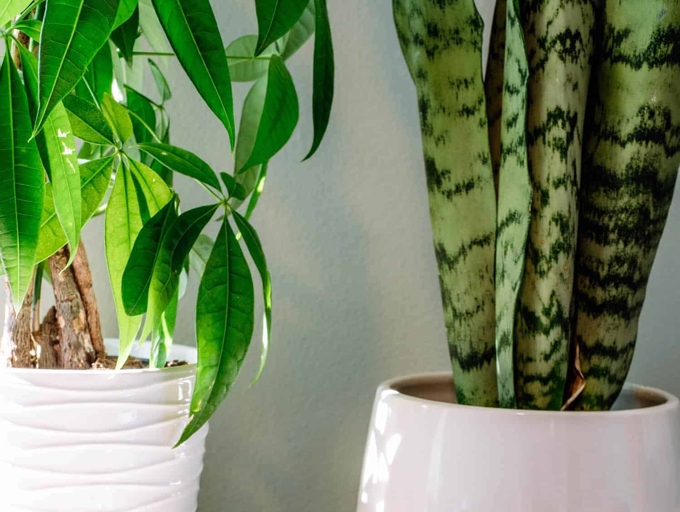
If the leaves are yellow and droopy, that’s a sign of overwatering. Allow the soil to dry out slightly between waterings and the yellowing should stop. Money trees like to be kept moist, but not soggy. If the leaves are yellow and crispy, that’s a sign of underwatering. Yellowing can also be caused by too much or too little water. Give your tree a good drink and the yellowing should stop.
If your tree is not getting enough nitrogen, phosphorus, or potassium, the leaves will start to turn yellow. Finally, yellowing leaves can be a sign of a nutrient deficiency. Use a fertilizer formulated for money trees and follow the directions on the package.
Septoria Leaf Spot Infects the Older Leaves
You can also try applying a fungicide to the affected leaves, but be sure to follow the directions carefully. To prevent the disease from spreading, remove and destroy infected leaves as soon as you see them. If you notice yellow spots on your money tree’s older leaves, it’s likely due to septoria leaf spot. This fungal disease infects the leaves through wounds or natural openings, causing them to turn yellow and eventually drop off. While septoria leaf spot is unsightly, it’s not usually fatal to the plant.
Solution
There are a few possible causes and treatments. If you notice yellow spots on your money tree, don’t panic.
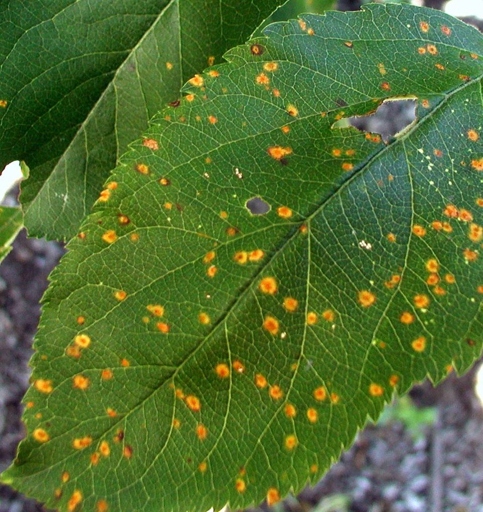
If you think your tree is getting too much sun, try moving it to a shadier spot. Yellow spots can be caused by a number of things, including too much sun, too little water, or a nutrient deficiency. If you think it’s not getting enough water, water it more frequently.
If you’re not sure what the problem is, try giving your tree a general purpose fertilizer. If the yellow spots don’t go away, or if they get worse, take your tree to a nursery or a plant doctor for a diagnosis.
Bacterial Spot
The bacteria can also cause the leaves to drop off the tree. The bacteria can also cause the leaves to turn yellow or brown. Bacterial spot is a common problem for money tree owners. The spots are most often found on the new growth of the leaves. The tree can also be treated with a fungicide. The spots are most often found on the upper surface of the leaves, but can also occur on the lower surface. They are caused by a bacteria that lives on the surface of the leaves. The spots are usually yellow, but can also be brown or black. The best way to control bacterial spot is to remove the affected leaves from the tree.
Solution
There are a few possible causes and treatments. If you notice yellow spots on your money tree, don’t panic.
If the spots are small and few, you can try moving your tree to a shadier spot and increasing the frequency of watering. Yellow spots can be caused by too much sun, not enough water, or a nutrient deficiency. If the spots are large and numerous, it’s best to consult a professional.
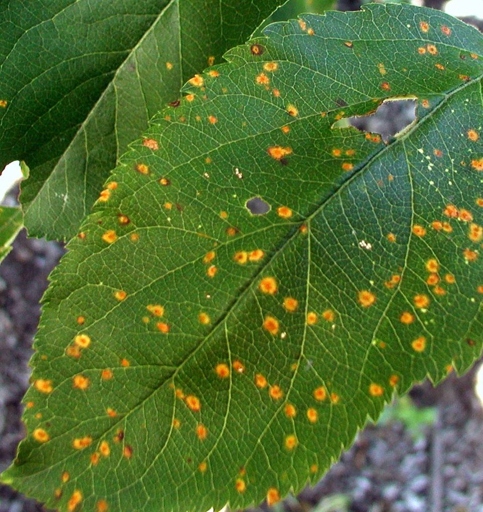
If your tree is not getting enough nitrogen, phosphorus, or potassium, it will start to yellow. These nutrients can be added to the soil through fertilizers or compost. A nutrient deficiency is a more serious issue that should be addressed by a professional.
If you’re not sure what’s causing the yellow spots on your money tree, the best course of action is to consult a professional. They will be able to diagnose the problem and recommend the best course of treatment.
Alternaria
This disease is caused by a fungus that lives in the soil and on plant debris. You can also treat the tree with a fungicide. The best way to control Alternaria is to remove infected leaves and debris from the area around the money tree. The symptoms of Alternaria include yellow spots on the leaves, leaf drop, and stunted growth. The fungus spreads through the air and infects the leaves of the money tree. If you notice yellow spots on your money tree, it’s likely due to a fungal disease called Alternaria.
Solution
There are a number of possible causes and treatments. If you notice yellow spots on your money tree, don’t panic.
One common cause of yellowing leaves is too much direct sunlight. If your money tree is in a sunny spot, try moving it to a shadier location.

Yellowing can also be caused by a lack of nutrients. If your tree isn’t getting enough nitrogen, phosphorus, or potassium, its leaves will start to turn yellow. You can solve this problem by fertilizing your tree with a balanced fertilizer.
Allow the soil to dry out completely between watering sessions. Finally, yellowing leaves can be a sign of overwatering. If your tree’s leaves are yellow and wilted, it’s probably getting too much water.
Powdery Mildew
In severe cases, the entire plant may die. Powdery mildew can cause the leaves of affected plants to turn yellow and eventually die. This fungus appears as a white or gray powdery substance on the leaves and stems of affected plants. Powdery mildew is a type of fungus that can affect a variety of plants, including money trees.
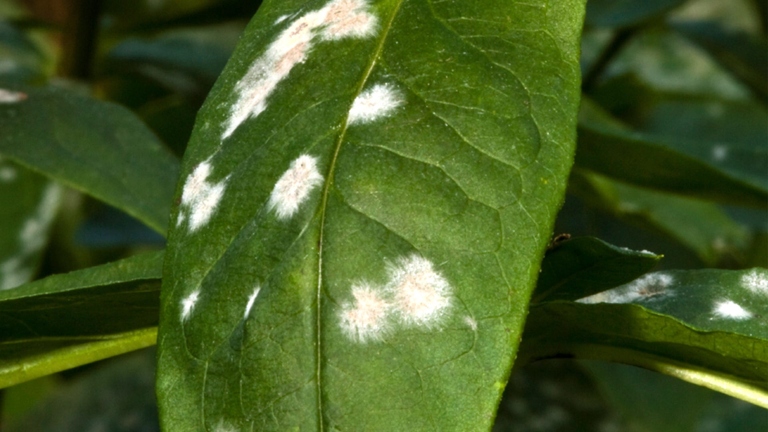
It is important to take action as soon as you notice powdery mildew on your money tree, as the fungus can spread quickly and cause serious damage. There are a number of ways to treat powdery mildew, including using fungicides and increasing air circulation around the affected plant.
Solution
There are a number of possible causes, and most of them are easily treatable. If you notice yellow spots on your money tree, don’t panic.
Money trees prefer bright, indirect light, so if yours is getting too much direct sun, the leaves will start to turn yellow. One common cause of yellowing leaves is simply too much sun. Move your tree to a shadier spot and see if the yellowing stops.

If your tree isn’t getting enough nitrogen, phosphorus, or potassium, the leaves will start to turn yellow. Another possible cause is nutrient deficiency. You can solve this problem by fertilizing your tree with a balanced fertilizer.
Let the soil dry out between waterings, and don’t water more than necessary. Finally, yellowing leaves can also be a sign of overwatering. Money trees don’t like to stay wet, so if the soil is constantly moist, the leaves will start to turn yellow and drop off.
Underwatering
This can happen for a number of reasons, including not enough water in the soil, not enough humidity in the air, or the plant is in a pot that’s too small. Underwatering is when the roots of a plant don’t have enough water. If you notice yellow spots on your money tree, it’s likely due to underwatering.
If the soil is already wet, the problem may be too little humidity in the air. If you think your money tree is underwater, the first thing to do is check the soil. Try misting the leaves of the plant or placing the pot on a pebble tray. If it’s dry, water the plant until the soil is saturated.
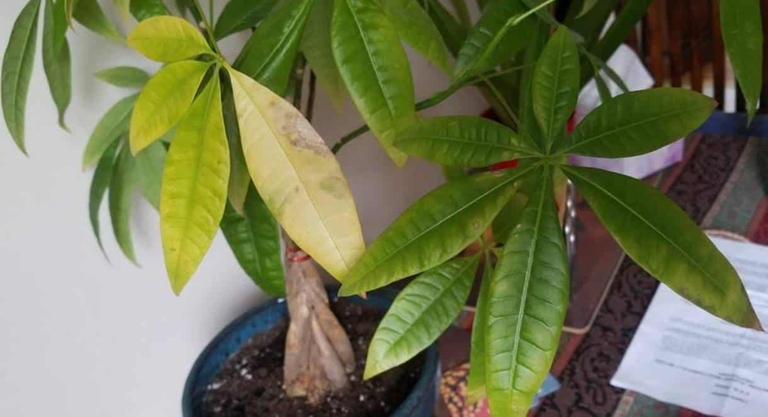
Water the plant well and continue to water it regularly, making sure the soil stays moist but not soggy. Choose a pot that’s about 2 inches wider than the current one and fill it with fresh potting mix. If you’re still having trouble, it may be time to repot your money tree.
Solution
There are a few possible causes and treatments. If you notice yellow spots on your money tree, don’t panic.
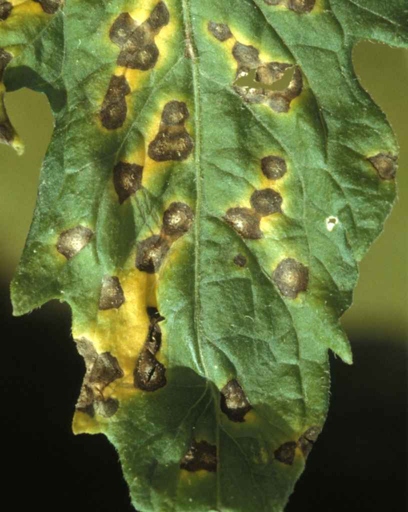
Yellow spots can be caused by too much sun, not enough water, or a nutrient deficiency. If you think your tree is getting too much sun, move it to a shadier spot. If you think it’s not getting enough water, water it more often.
A nutrient deficiency is a little more tricky to fix. You’ll need to test your soil to see what’s missing and then add the appropriate fertilizer.
They should be able to help you diagnose the problem and find a solution. If you can’t figure out what’s causing the yellow spots, take a sample of the leaves to your local nursery or Cooperative Extension office.
Overwatering
The leaves of the tree will start to turn yellow and drop off if the tree is getting too much water. The best way to water a money tree is to allow the top inch of soil to dry out before watering again. If you think your tree is overwatered, check the soil to see if it is soggy or wet. One of the most common problems with money trees is overwatering.
Solution
There are a number of possible causes, and most of them are easily treatable. If you notice yellow spots on your money tree, don’t panic.

Money trees prefer bright, indirect light, so if yours is getting too much direct sun, the leaves will start to turn yellow. One common cause of yellowing leaves is simply too much sun. Move your tree to a spot with less sun exposure and the yellowing should stop.
Be sure to fertilize your money tree regularly, using a balanced fertilizer formulated for foliage plants. Another common cause of yellowing leaves is a lack of nutrients. If your tree is not getting enough fertilizer, the leaves will start to turn yellow.
If the yellowing leaves are accompanied by wilting or drooping, it could be a sign of overwatering. Money trees are susceptible to root rot, so it’s important not to water them too often. Allow the top inch or so of soil to dry out before watering again.
With a little care, your money tree will be back to its healthy, green self in no time. If you can’t identify the cause of the yellowing leaves, take a sample of the affected leaves to your local nursery or Cooperative Extension office for diagnosis.
Fertilizer Burn
The leaves of the money tree will start to turn yellow and then brown and eventually drop off if the tree is not getting the proper nutrients. Fertilizer burn is one of the most common problems when it comes to growing money trees. Fertilizer burn can be caused by over-fertilizing, using the wrong type of fertilizer, or not watering the tree properly.
If you are unsure about how often to fertilize, it is best to err on the side of caution and fertilize less often. To avoid fertilizer burn, it is important to follow the directions on the fertilizer package and only fertilize the tree when it is necessary. It is also important to make sure that you are using the right type of fertilizer for your money tree.
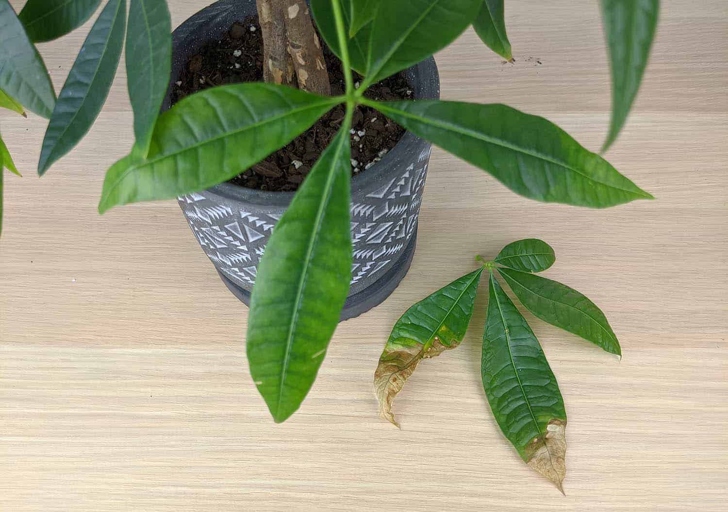
If you think that your money tree has fertilizer burn, the best course of action is to stop fertilizing and to start watering the tree more frequently. Once the leaves start to turn green again, you can slowly start fertilizing the tree again.
Solution
There are a few possible causes and treatments. If you notice yellow spots on your money tree, don’t panic.
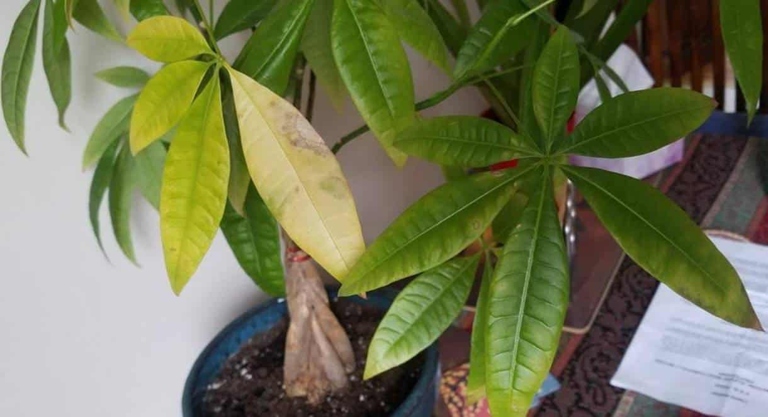
One possible cause is too much sun. If you think your tree isn’t getting enough food, try fertilizing it. Another possible cause is lack of nutrients. If your money tree is in a sunny spot, try moving it to a shadier location.
You can try using a natural pest control method like neem oil, or you can contact a professional for help. If the yellow spots are caused by a pest infestation, you’ll need to take action to get rid of the pests.
Whatever the cause of the yellow spots, don’t give up on your money tree. With a little care, it will soon be green and healthy again.
Nutrient Deficiency
If your money tree has yellow spots, it could be a sign of nutrient deficiency. These nutrients are essential for the growth and health of money trees. A lack of any one of these nutrients can cause yellowing of the leaves. The most common nutrient deficiencies in money trees are nitrogen, phosphorus, and potassium.
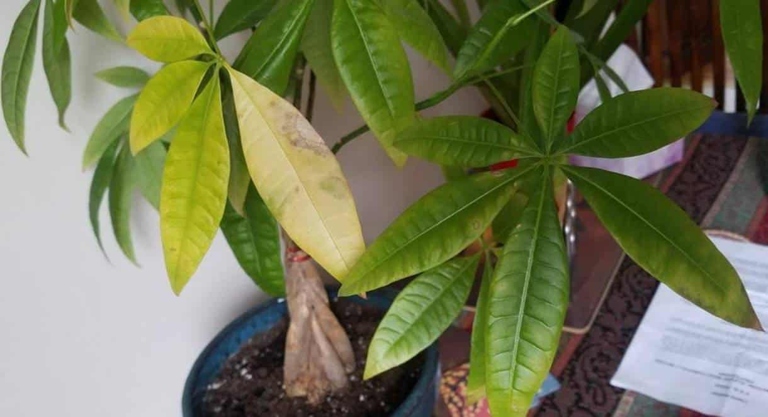
Nitrogen is responsible for the growth of leaves and stems. A lack of nitrogen will cause the leaves to turn yellow and the stems to stop growing. A lack of potassium will cause the leaves to turn yellow and the fruit to drop off the tree. A lack of phosphorus will cause the leaves to turn yellow and the flowers to wilt. Potassium is responsible for the growth of fruit and the overall health of the tree. Phosphorus is responsible for the growth of roots and flowers.
You can also try to correct the problem by adding compost to the soil around the tree. If your money tree has yellow spots, you can try to correct the problem by fertilizing the tree with a balanced fertilizer that contains all three of these nutrients.
Solution
There are a few possible causes, and most of them are easy to fix. If you notice yellow spots on your money tree, don’t panic.
If the yellowing is widespread, it’s probably due to one of these environmental factors. Yellow leaves can be caused by too much sun, too little water, or a nutrient deficiency.
Check the affected leaves for signs of insects or disease. If the yellowing is limited to a few leaves, it may be due to a pest problem.
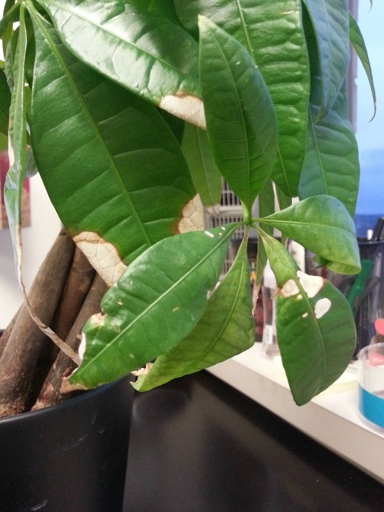
This will help your money tree to focus its energy on new growth. If you can’t identify the cause of the yellowing, try trimming off the affected leaves.
Edema
Edema can be caused by a variety of factors, including pregnancy, medications, and underlying medical conditions. It occurs when fluid accumulates in the body’s tissues. Edema is the medical term for swelling.
If the cause is unknown or mild, edema may resolve on its own. More severe cases may require medication or surgery. There are several treatment options for edema.
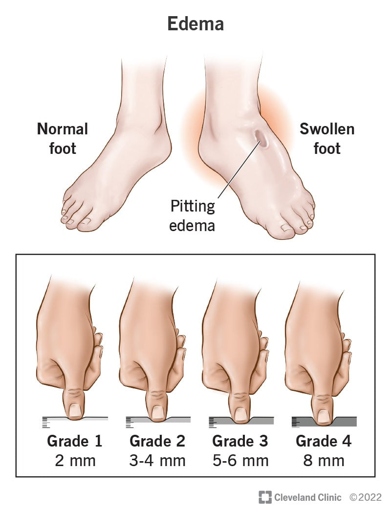
However, with proper treatment, most people with edema can manage their symptoms and live relatively normal lives. Edema is a common condition that can be uncomfortable and inconvenient.
Solution
There are a few possible causes and treatments. If you notice yellow spots on your money tree, don’t panic.
One possible cause is too much direct sunlight. If your money tree is in a sunny spot, try moving it to a more shady location.
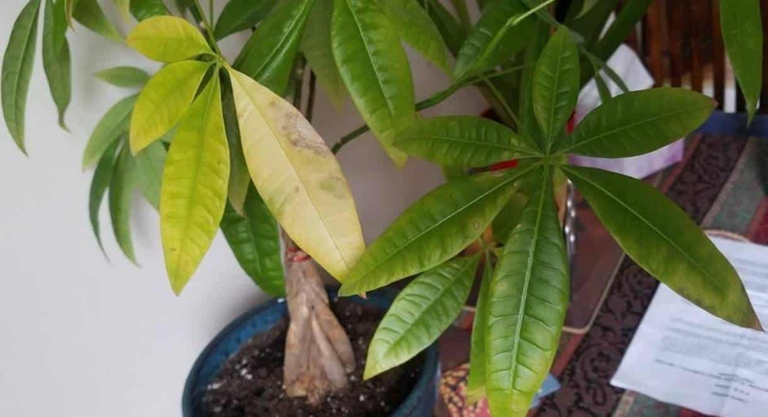
If your tree is not getting enough nutrients, you can try fertilizing it. Another possible cause is lack of nutrients.
If the yellow spots are caused by a pest infestation, you’ll need to treat the tree with an insecticide.
Whatever the cause, yellow spots on your money tree can usually be treated fairly easily. With a little care, your tree will be back to its healthy self in no time.
Frost Damage
The leaves of the money tree are very sensitive to cold temperatures and can be easily damaged by frost. Frost damage is one of the most common problems that money tree growers face. The damage from frost can range from small yellow spots on the leaves to complete leaf death.
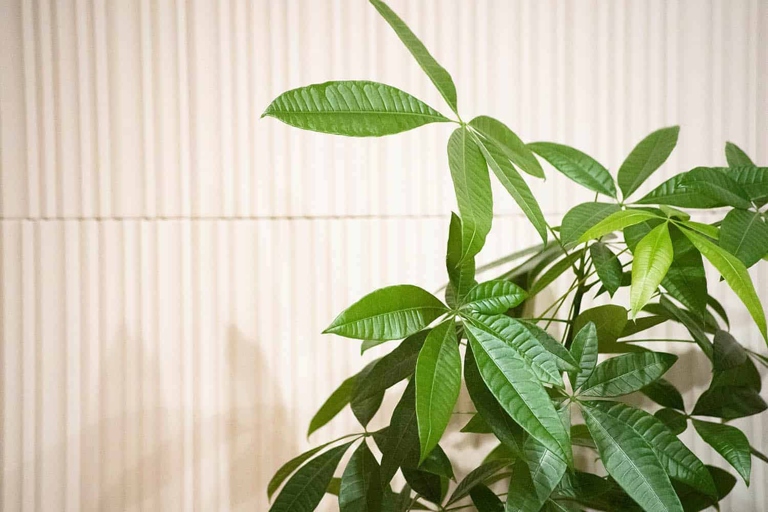
You can also wrap your tree in a blanket or tarp to insulate it from the cold. If you live in an area that is prone to frost, it is important to take steps to protect your money tree from the cold. One way to do this is to plant your tree in a pot that can be brought inside if the temperature drops.
In most cases, the tree will recover on its own given time and proper care. If your money tree does suffer frost damage, there is no need to panic. However, if the damage is severe, you may need to consult with a professional to determine the best course of action.
Solution
If you’re concerned about yellow spots on your money tree, there are a few things you can do to treat the problem. If the spots are due to sun damage, you can try moving the plant to a shadier location. If the spots are due to a nutrient deficiency, you can try fertilizing the plant. First, try to identify the cause of the problem. If the spots are caused by a fungal infection, you can try treating the plant with a fungicide.
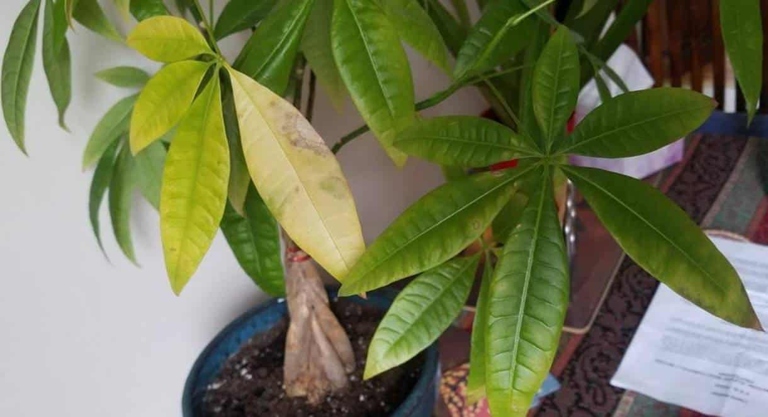
If you can’t identify the cause of the problem, or if the yellow spots are spreading, you can try pruning the affected leaves. You can also try treating the plant with a general-purpose pesticide. This will help to prevent the problem from spreading to other parts of the plant. If the problem persists, you may need to consult a professional.
Low Humidity
If you live in a dry climate, you’ll need to take extra steps to keep your money tree healthy. Money trees are native to tropical regions and need high humidity to thrive. If you notice yellow spots on your money tree, it could be a sign of low humidity.
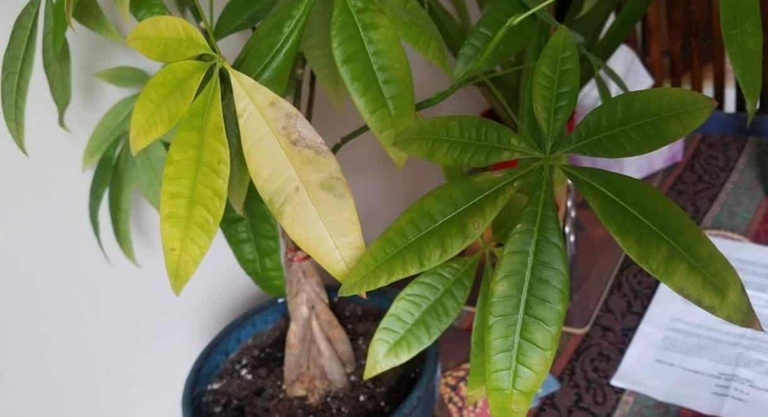
If they do, it could be a sign of a more serious problem. You can also put your money tree in a bathroom or kitchen, where the humidity is typically higher. To increase the humidity around your money tree, you can use a humidifier or mist the leaves with water. Keep an eye on the yellow spots and make sure they don’t spread.
Solution
There are a number of possible causes, and most can be easily remedied. If you notice yellow spots on your money tree, don’t panic.
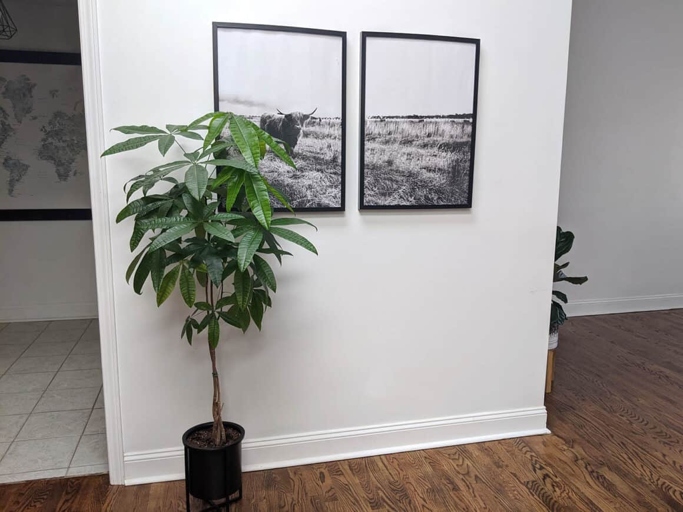
Money trees prefer bright, indirect light, so if yours is in a sunny spot, move it to a shadier location. One common cause of yellowing leaves is simply too much sun.
Feed your money tree with a balanced fertilizer every two weeks during the growing season, and monthly during the winter. Another possible cause is lack of nutrients.
If the yellowing leaves are accompanied by wilting, it could be a sign of overwatering. Allow the soil to dry out completely between waterings.
With a little investigation and some simple care, you can get your money tree back to its healthy, green self in no time.
Insect Infestation
If you notice yellow spots on your money tree, it’s likely due to an insect infestation. There are a few different insects that can infest money trees, including mealybugs, scale, and spider mites. These pests feed on the sap of the tree, which can cause the leaves to yellow and eventually drop off.
You may need to treat the tree multiple times to completely get rid of the pests. To get rid of an insect infestation, you’ll need to treat the tree with an insecticide. Be sure to follow the instructions on the label carefully, as money trees are sensitive to some pesticides.
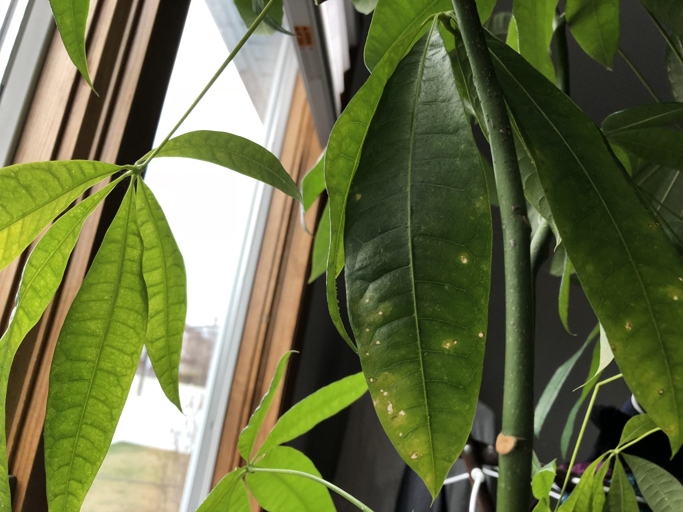
They will be able to properly identify the pests and treat the tree accordingly. If your money tree is severely infested, you may need to consult a professional pest control company.
Solution
There are a few possible causes, and most of them are easily remedied. If you notice yellow spots on your money tree, don’t panic.
Money trees prefer bright, indirect light, so if yours is getting too much direct sun, the leaves will start to turn yellow. Move your tree to a shadier spot and the yellowing should stop. One common cause of yellowing leaves is simply too much sun.
Yellowing can also be caused by too much or too little water. If your tree is getting too much water, the leaves will start to yellow and drop off. Try to water your tree once a week, letting the soil dry out slightly between waterings. If it’s not getting enough water, the leaves will also turn yellow.
If you think your tree is getting the right amount of water and light but the leaves are still yellowing, it could be a nutrient deficiency. Fertilize your tree every few months to make sure it’s getting the nutrients it needs.
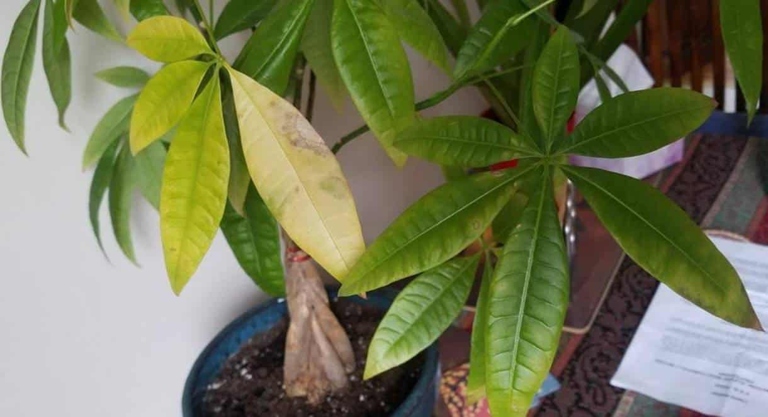
With a little care, your money tree will be green and healthy in no time. Most yellowing problems can be easily fixed with a little trial and error.
Frequently Asked Questions
1.What are the yellow spots on my money tree?
There are a few possible explanations for yellow spots on a money tree. It could be caused by too much sun, not enough water, or a nutrient deficiency. It could also be a sign of a pest infestation or disease.
2. Why does my money tree have yellow leaves?
There are a few possible explanations for yellow leaves on a money tree. It could be caused by too much sun, not enough water, or a nutrient deficiency. It could also be a sign of a pest infestation or disease.
3. How do I treat yellow spots on my money tree?
If the yellow spots are caused by too much sun, move the tree to a shadier spot. If the spots are caused by not enough water, water the tree more frequently. If the spots are caused by a nutrient deficiency, fertilize the tree. If the spots are caused by a pest infestation, treat the tree with an insecticide. If the spots are caused by a disease, treat the tree with a fungicide.
4. How do I prevent yellow spots on my money tree?
To prevent yellow spots on your money tree, make sure to water it regularly and fertilize it as needed. You should also avoid placing it in direct sunlight.
5. What are the most common causes of yellow spots on money trees?
The most common causes of yellow spots on money trees are too much sun, not enough water, and a nutrient deficiency.
Final thoughts
If you have a money tree with yellow spots, it could be due to any of the 14 causes listed in the article. But don’t worry, there are treatments for all of them. Just figure out what’s causing the yellow spots, and follow the treatment instructions. With a little care, your money tree will be green and healthy in no time.
